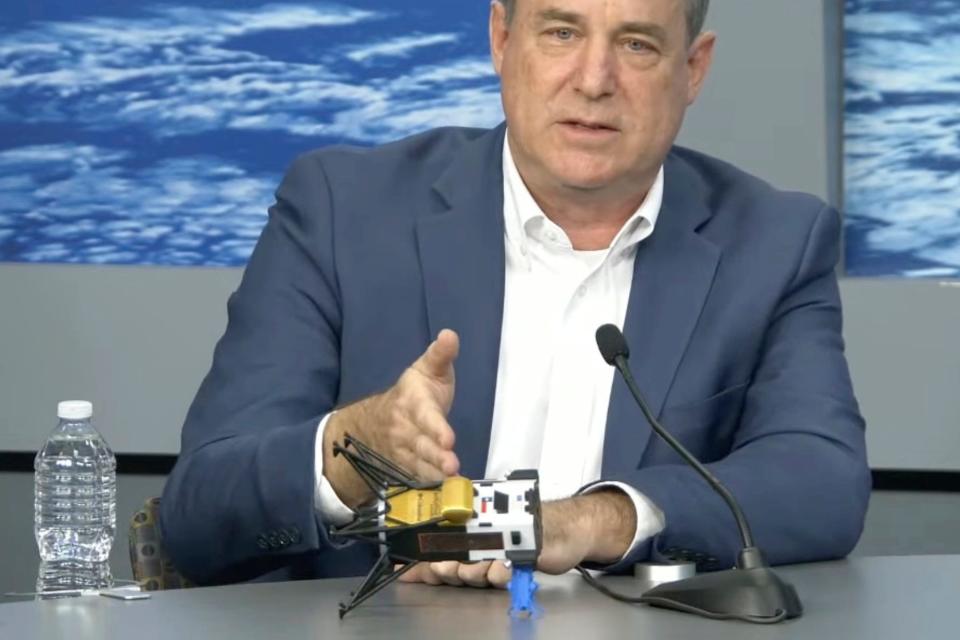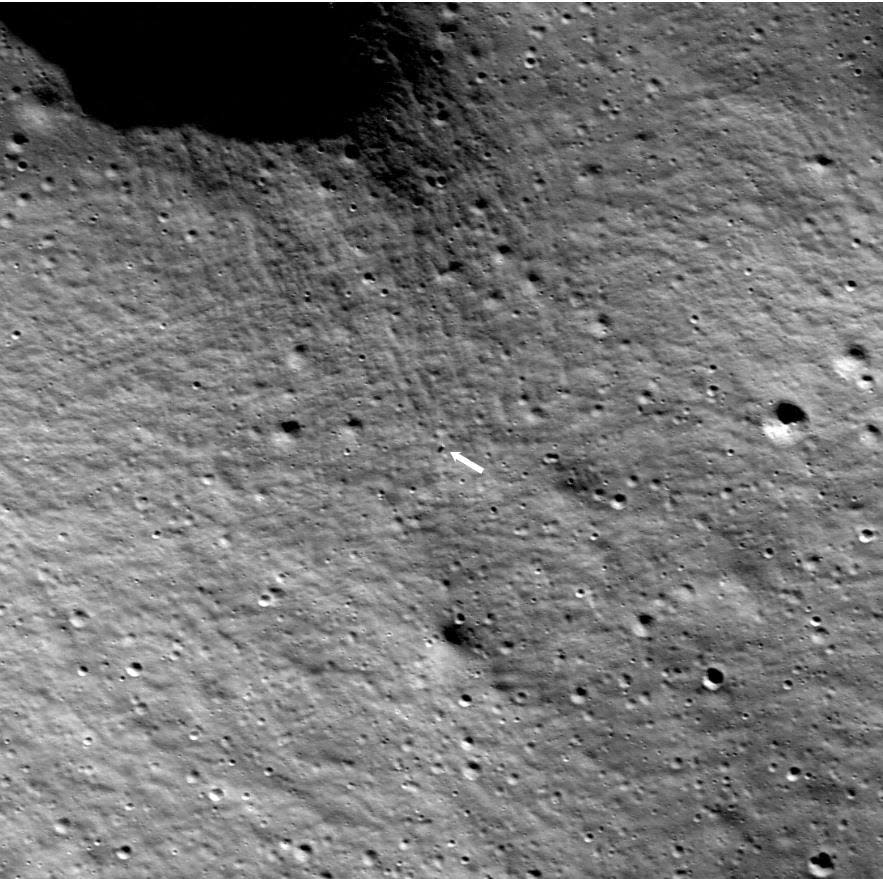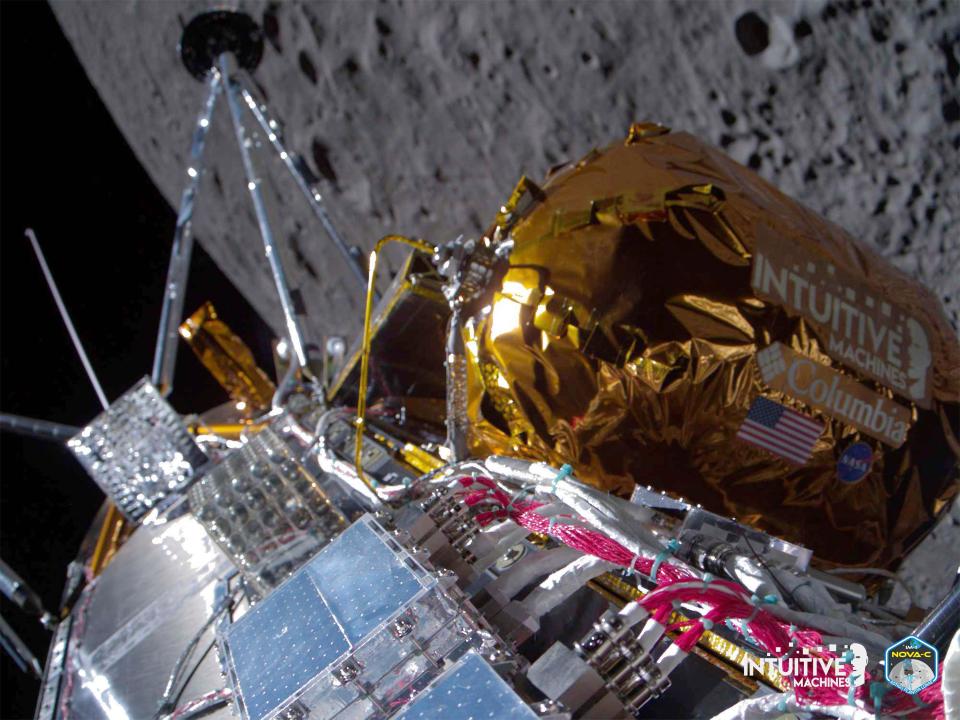Moon landing goes sideways: Odysseus mission will be cut short after craft tipped over
Flight controllers are expected to lose contact Tuesday or Wednesday with the Odysseus lunar lander – just days after it toppled over while completing a historic moon landing.
The private U.S. spacecraft made it to the moon last Thursday and ushered in a new era of lunar missions since NASA's Apollo program ended five decades ago.
Then things went, well, sideways.
Flight controllers intend to collect data until the lander’s solar panels are no longer exposed to light. Based on Earth and Moon positioning, we believe flight controllers will continue to communicate with Odysseus until Tuesday morning. Image credit: NASA/Goddard/Arizona State… pic.twitter.com/FFt8CXZPIC
— Intuitive Machines (@Int_Machines) February 26, 2024
Intuitive Machines, the Houston space company that built Odysseus, said it's likely that the 14-foot-tall lander tipped over when it touched down on the moon after its foot caught on a rock. Fortunately for Intuitive Machines – and for NASA, the mission's primary customer – the lander maintained limited function even though its antennas were not pointed at Earth.
Mission controllers at the company rushed to gather as much data as they could, but they knew time was not on their side. Now, the energy-deprived spacecraft is expected to soon cease operating as its batteries drain and the sun moves across the sky away from its solar panels, Intuitive Machines said Monday.
On Tuesday morning, the company said the spacecraft had about 10 to 20 hours before losing contact.
Supermassive black hole: Massive sun-devouring quasar with black hole found 'hiding in plain sight'
What caused the lunar spacecraft to land on its side?
Odysseus was able to enter lunar orbit last Wednesday after separating from the SpaceX rocket, establishing communications with ground controller and powering onward to the moon.
When it finally came time to attempt a landing Thursday evening, the spacecraft failed to land on its six legs and instead came down on its side.

NASA's Lunar Reconnaissance Orbiter later confirmed the precise location of Odysseus' landing site, which serves as the southernmost location where any craft has ever landed on the moon, Intuitive Machines said. Based on the orbiter's photos, Odysseus landed within about a mile of its intended target near the Malapert A crater, just 185 miles from the moon’s south pole.
Officials at Intuitive Machines believe that the craft landed too fast and may have caught one of its six landing pads in the lunar surface, forcing it to topple. The landing strut may also have snapped. The overturned lander covered some antennas and left others near the ground, delaying the rate at which data can be received on Earth, Intuitive Machines said.
Lander sends back photos, collects data before demise
As of Monday, Odysseus was still in communication with flight controllers in Houston and was able to beam back the first images from the lunar surface, Intuitive Machines said.

Visuals: Odysseus tipped over and landed on its side on the moon's surface
Flight controllers intended to collect data until the lander's solar panels were no longer exposed to the sunlight and and the craft died, which was initially projected to be Tuesday morning, the company said. Even if it landed upright, Odysseus only had a week to operate on the surface before the long lunar night replaced the sun and brought in negative temperatures.
“Flight controllers intend to collect data until the lander’s solar panels are no longer exposed to light,” Intuitive Machines posted Monday on social media site X.
NASA sent cargo aboard Odysseus for its own moon missions
As the primary customer on the lunar mission, NASA paid Intuitive Machines $118 million to take its scientific payloads to the moon for its Commercial Lunar Payload Services program, or CLPS.
The U.S. space agency has a budget of $2.6 billion in contracts available through 2028 to pay private companies like Intuitive Machines to transport scientific payloads on private robotic landers like Odysseus bound for the lunar surface.

Among the cargo were tools to test plume-surface interactions and measure both radio astronomy and space weather interactions with the lunar surface.
NASA had hoped the scientific instruments would be able to collect valuable data as it prepares to send astronauts back to the lunar surface for its since-delayed Artemis program. Now that the mission was cut a few days short, it's unclear how much valuable intel NASA was able to receive.
“This feat from Intuitive Machines, SpaceX, and NASA demonstrates the promise of American leadership in space and the power of commercial partnerships," NASA Administrator Bill Nelson said in a statement a day after the landing. "Further, this success opens the door for new voyages under Artemis to send astronauts to the Moon, then onward to Mars.”
Odysseus made landing near moon's south pole
The uncrewed Odysseus spacecraft touched down late Thursday on the surface of the moon, one week after launching aboard the SpaceX Falcon 9 rocket from NASA’s Kennedy Space Center in Cape Canaveral, Florida.
Appropriately named for the Greek hero of Homer's epic poem "The Odyssey," the lander became the first built by a private company to make it to the moon. The landing also signaled America's return to the moon for the first time since NASA's Apollo program came to an end in 1972.
Intuitive Machines built and operated Odysseus to carry cargo for NASA and other private customers to the lunar surface for its IM-1 mission. Formally called a Nova-C, the lander is a hexagonal cylinder with six legs that the space company has operated from a mission control center in Houston.
It landed near Malapert A, a small crater about 190 miles from the moon's south pole region where water ice is thought to be abundant.
The substance's presence would be vital as NASA looks to establish a permanent human presence on and around the moon ahead of future missions to Mars. Water ice would not only sustain astronauts on the surface, but would also be be a source of hydrogen and oxygen for rocket fuel.
The landing came about a month after another U.S. company, Pittsburgh-based Astrobotic Technology, attempted an uncrewed moon landing of its own with its Peregrine lander. However, the doomed mission encountered a critical fuel leak that ended with the spacecraft burning up in Earth's atmosphere days later.
Eric Lagatta covers breaking and trending news for USA TODAY. Reach him at [email protected]
This article originally appeared on USA TODAY: Odysseus moon lander tipped over, will lose power in hours
